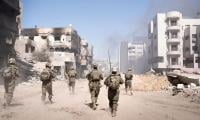All countries have a Higher Defence Organisation (HDO) specifically geared to their national security needs based on their geostrategic environment and historical experiences. Our colonial bequest left us with a tri-service model where the three services operate completely independently modelled almost upon the same pattern that the British Indian Army followed in the Subcontinent.
The appointment of a commander in chief who was answerable to the viceroy directly was almost always held by army officers with the air force and the navy as independent but subordinate appendages headed by their own officers. Since the minuscule size of the Royal Navy and Air force in India compared to the army precluded any inter-services rivalries or friction, the model operated with requisite success in that environment. The system, however, was ill-suited to our post-colonial strategic needs and political aspirations.
The military-centric flavour of our HDO has continued ever since the appointment of General Ayub Khan, a sitting C-in-C, as defence minister in 1954. Initially the navy and the air force were part of the GHQ and after attaining full independent service status became part of the Joint Chiefs Committee that further evolved into a Joint Chiefs Secretariat headed by the army chief as a moderator in 1951. The three services continued planning service strategies and war plans independently in isolation.
The 1965 and 1971 wars were fought under the same system where the sister services’ chiefs came to know of the war’s declaration through radio broadcasts. In 1976 a new HDO was established through a White Paper by the PPP government, replacing the Joint Chiefs Secretariat with a Joint Staff Headquarters (JSHQ) headed by a permanent chairman from any one of the services. The budding HDO received a jolt with the deposition of the democratic government by Zia’s martial law and the JSHQ remained a toothless sinecure headed by a four star officer with only ceremonial powers.
The British and American models, despite some major differences, offer singleness of planning and command without compromising on the operational efficacy of the three services. The UK – after which we modelled our HDO – changed its system by creating a chief of defence staff (CDS) who acts as the sole military advisor and conduit to the civilian tier headed by the secretary of the state, answerable to the prime minister. The individual service chiefs in UK deal only with training and administration while the CDS exercises operational control over three services.
While the UK’s Ministry of Defence headed by a secretary of defence acts both as a government department as well as a military headquarters, our Ministry of Defence is just an effete government department with no real decision-making or policy formulation powers. Now why would one recommend a UK-like model for Pakistan? The answer lies in efficiency and economy.
The experience of our three wars shows that the three services conducted their operations in a desultory manner sans a coherent military strategy that could synergise the operational strategies on land, sea and air. In this age of net centric warfare where cooperation in planning and execution is an operational imperative no single service can cast its lone furrow. The integration and synchronicity in our air, maritime and land strategies demand a singleness of strategic vision which is not possible without a central headquarters to exercise operational control over the three services.
The present Joint Chiefs of Staff Committee headed by a chairman is more of a debating forum where the three services merely flag attention to their areas of concern without having any influence to effect any meaningful changes in employment or development strategies. The biggest advantage of the current system – operational and administrative independence – is becoming an albatross around the neck of a resource starved country. Countries richer than us have effected changes in their HDO precisely for this reason.
The current HDO model results in wastage and duplication of resources in procurement, military engineering services, medical support, and logistic functions. The best remedy is to institute the appointment of a four-star CDS who, in addition to being the only chief military advisor to the government, would exercise effective control on tri-service operations, promotions and postings. The service chiefs under the CDS should be responsible only for training and administration as is done in the the British and American armies.
In order to reflect the operational and strategic balance the COAS should be elevated to the slot of CDS after his three years. It is time to seriously debate this idea, which will help yield rich dividends in terms of efficiency and economy as well as set our civil-military balance on an even keel.
The writer is a retired brigadier, and a PhD scholar in Peace and Conflict Studies at the National University of Science and Technology, Islamabad.
Representational image. — APP FileOnce again there is debate surrounding the National Finance Commission Award,...
Pakistani human rights activist and Supreme Court lawyer Asma Jahangir died on February 11, 2018. — AFPAn annual...
Representational image. — APP FileThe meltdown of Pakistan’s economy needs immediate attention. Political unrest...
A health worker administers polio vaccine drops to a child during a door-to-door polio vaccination campaign in Lahore,...
Armed militants of the banned Tehreek-e-Taliban Pakistan pose for a photograph in Orakzai Agency. —...
An aeroplane of the national flag carrier of Pakistan is seen in this file photo. — AFPWhile Pakistan considers...







